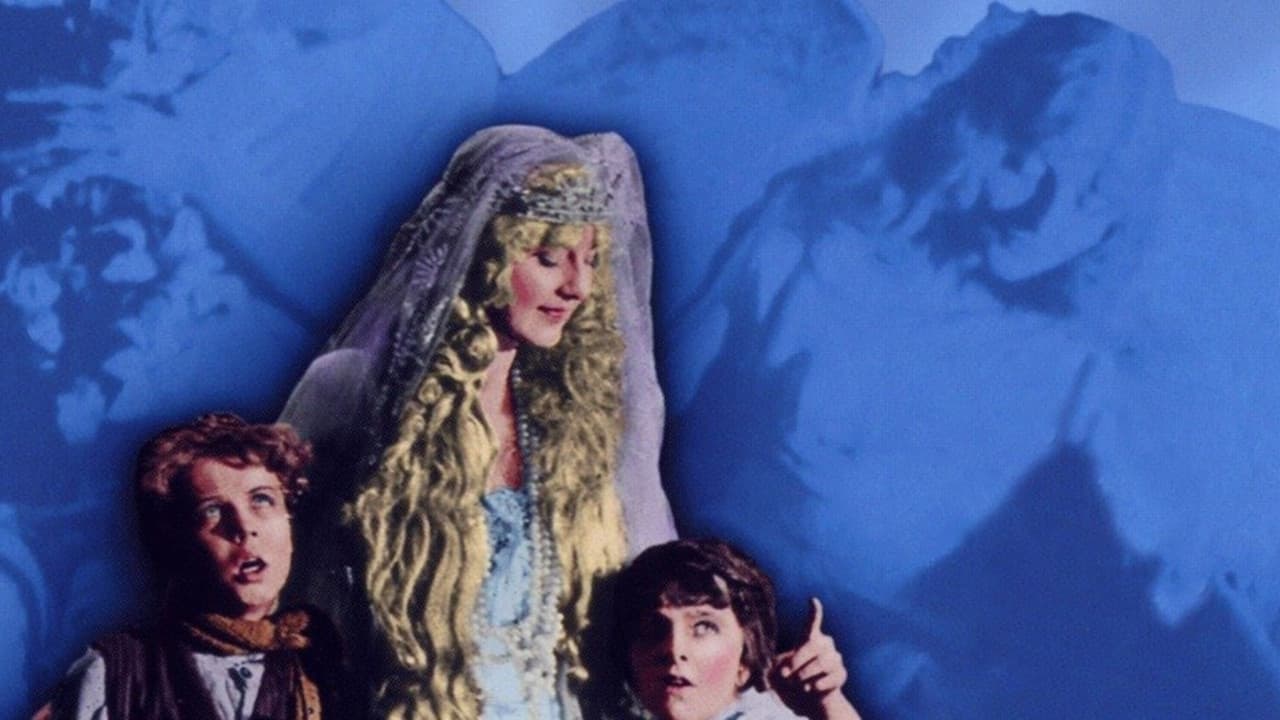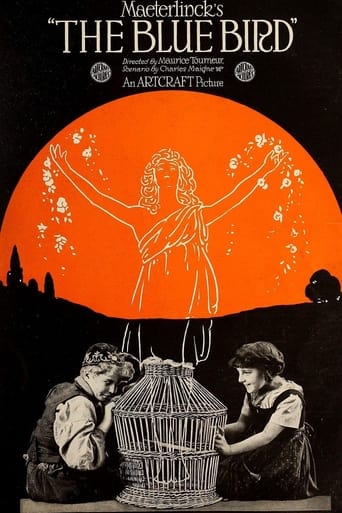



Good concept, poorly executed.
Dreadfully Boring
Although it has its amusing moments, in eneral the plot does not convince.
View MoreI think this is a new genre that they're all sort of working their way through it and haven't got all the kinks worked out yet but it's a genre that works for me.
View MoreIt's a pity that the 1918 version of "The Blue Bird" suffers so much from nitrate decomposition. Were it not for that I would give it a full 10 points. Nonetheless, what we have is sufficient to give great pleasure and it is certainly far superior to the 1940 version with Shirley Temple.Some of the scenes have a rather staged look but, even so, one admires the beautiful—often elegant—artistic consciousness in their presentation. This is particularly true of the backdrops. Generally, I thought the restoration was pretty good with effective use of tinting to make the most of the emotional atmosphere of the various sequences.I liked the presentation of the message—always an important factor in a fairy tale. The quest for happiness which is always found to be closer than we expect, the discovery of joy in the joy of others, the beautiful and wonderful intangible world of the imagination and the truth of dream—all these are beautifully presented through the innocence of the children. And here one must admire the performances of little Tula Belle as Mytyl and Robin Macdougall as Mytyl's older brother, Tyltyl. Tula, particularly, has an engaging naturalness which is wonderful. Dog and Cat look forward to "The Wizard of Oz" and the actors certainly convey the habits of the creatures they portray.The allegory with its spiritual message was reminiscent of the Narnian series of C.S. Lewis and the way the point was driven home at the end was very effective. Finally, I think that the music score showed excellent taste and skill in the way it was wedded to the film.The Blue Bird is a beautiful film with a universal message.
View MoreAs it is well-known among silent film connoisseurs, the fine Arts were an essential influence on silent films in general and Herr Maurice Tourneur's work in particular. His beautiful oeuvres gave him fame and prestige around the world from his French period in the mid 10's to his career in the USA."The Blue Bird" (1918) tells the story of two poor children, Mytyl and Tyltyl, who are led by the fairy Berylune in the search, around a fantastic world, for the blue bird of happiness. The film belongs to Herr Tourneur's American silent film period, and in this movie it is possible to watch all his artistic virtues in full display. This early astounding production is striking even today for its great artistic merits. The film was based on a book written by the Belgian poet Herr Maurice Maeterlinck and maybe Herr Tourneur during his young days could have illustrated it due to his earlier career as a book illustrator or MEIN GOTT!!! Perhaps he even read it! In any case, Herr Tourneur adapted and transferred the fairy tale story to the silent screen in a superb way.The film exudes classicism and even romanticism, artistic subjects that Herr Tourneur know very well how to employ in the world of fantasy. There is amazing art direction, elaborate decors and costumes and witty technical effects, not to mention the inventiveness that can be seen in every shot of the film and in the beautiful, exemplary photography of Herr John van den Broek and Lucien Andriot that captures the atmosphere of the classical fairy books through a cinema lens in a masterly way.Probably the story can be considered as affected, even innocent in this modern time but even that has a special value in artistic terms for this film; that baroque taste and out of date atmosphere fit perfectly in the story that moves from the real to the dream world, from the real to the unreal. Herr Tourneur's interpretation of this fantastic universe is a prodigious work, imaginative and inventive and shining with brilliant artistic merits.And now, if you'll allow me, I must temporarily take my leave because this German Count must listen to the gracious caw of the Schloss crows.Herr Graf Ferdinand Von Galitzien http://ferdinandvongalitzien.blogspot.com/
View MoreThe Belgian author and symbolist playwright Maurice Maeterlinck was a very popular literary figure of his day. His play "Pelléas et Mélisande", in fact, inspired at least four well-known musical works by Fauré, Schönberg, Sibelius and, most famously, the full-length opera of the same name by Claude Debussy.The heavy symbolism of his plays including his "fairy" play, "L'Oiseau Bleu" (The Blue Bird.) from 1909 apparently intrigued the public in the first part of the 20th century. But when his works were placed on the Roman Catholic Index of Forbidden Books, they, naturally, became even more popular! There have been many film versions of "The Blue Bird", most notably, the unsuccessful 1940 version with Shirley Temple and the 1976 Russian-American disaster with Elizabeth Taylor. The present film is a 1918 silent film by the renowned French director (working in America at this time.) Maurice Tourneur.The cast of this film is unfamiliar to present-day audiences. The little girl who played Mytyl was Tula Belle (Hollingshead); she was born in Norway (to an American father at least.) and died in California in 1992! The boy Robin MacDougall seems to have made only this one film and the rest of the cast are not likely to be alive in 2007 as they'd mostly have to be well over 100. So this is a fascinating look at long-gone film techniques and acting styles.The DVD is based on an obviously deteriorated print but restored, as well as possible, at the George Eastman House in Rochester, New York. Various scenes were tinted in accordance with the theories of what each scenes' mood was meant to be. The "special effects" were adequate for the period but obviously not up to modern computer-generated effects.The characters are generally allegorical with actors portraying the personifications of Light, Night, Dog, Cat, Water, Milk, Bread etc. The lengthy scene with unborn children clearly mirrored the ideology of the time that one has a duty to have many children. A similar scene with the voices of unborn children in the Richard Strauss opera (1918 coincidentally.) "Die Frau Ohne Schatten" (The Woman Without a Shadow"), a similar ode to fecundity, shows the obvious influence of this play and probably mirrors the attitudes against Margaret Sanger and her birth-control followers. (But Sanger largely prevailed, at least in the U.S.) Another obvious influence of this play is on the 1939 film "The Wizard of Oz". In Judy's last speech, she realizes that if happiness can't be found at home "in your own backyard", it can't be found at all. There was also a popular but now rather campy song made popular by Jan Peerce in 1948, "Bluebird of Happiness". (He did an earlier version in 1935.) This DVD is an important reminder of these old attitudes and it certainly has its moments of beauty. On the whole, though, it is, in my opinion, rather of a "hoot". The acting is strictly of the period and everything else about it is quite dated.
View Morethe blue bird from 1918 is one of the most beautiful, captivating films of all time. it is the story of 2 poor children who are visited by a fairy on Christmas eve. the fairy shows them how to see things through the eyes of God. she teaches them about what is truly important in life. they follow the fairy through many events and learn something new from each experience. if you have not seen this great silent film or have seen another version, then please take the time to watch this masterpiece, you will never forget it. the young girl who plays mytel (tula belle) is nothing short of tremendous. her acting is very natural and has a realism i've never seen in another child star. tula's facial expressions even without speech, is more effective than most child stars with both mediums. tula belle's performance in the blue bird is probably the single best performance by a child star of all time.
View More